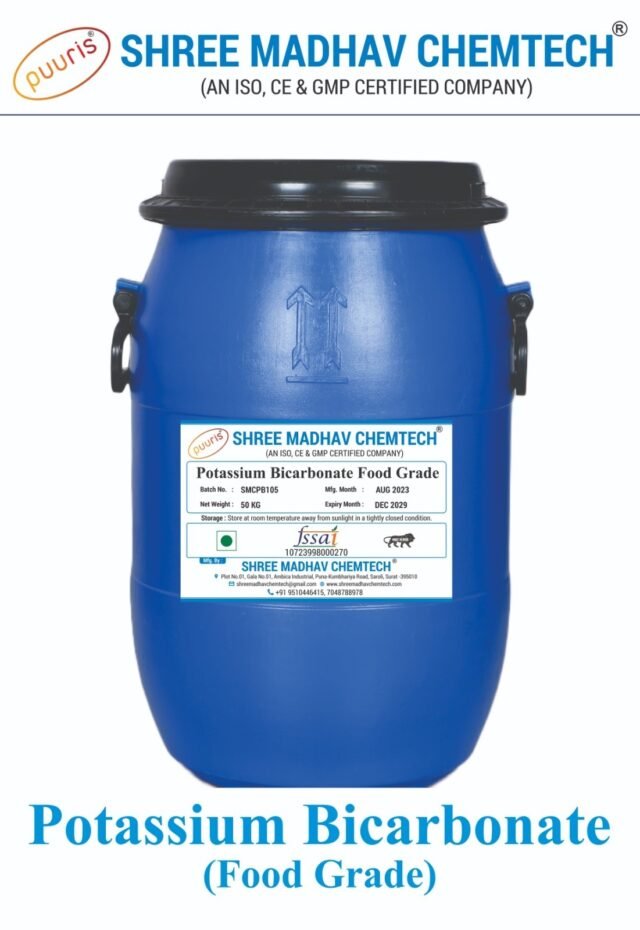POTASSIUM BICARBONATE :-
Potassium bicarbonate (KHCO₃) is a white powder, crystalline, slightly alkaline salt with a salty taste. It’s a potassium salt of carbonic acid, commonly used as a dietary supplement, buffering agent, and in various industrial and agricultural applications. Potassium bicarbonate is a high-purity form of potassium bicarbonate (KHCO₃) specifically manufacturers and processed to meet strict safety and quality standards for use in food and beverage applications.
Pack Size : 5 kg, 25 kg & 50 kg

Chemical Formula: KHCO₃
Molecular Weight: 100.12 g/mol
Appearance: White, odorless crystalline powder or granules
Purity: Typically ≥99% pure, meeting food-grade standards (e.g., FCC – Food Chemicals Codex or equivalent).
Solubility: Highly soluble in water (~33 g/100 mL at 20°C), insoluble in alcohol.
pH: Aqueous solutions are mildly alkaline (pH ~8.2–8.5).
Taste: Slightly salty and alkaline, less intense than sodium bicarbonate.
Odor: Odorless, making it suitable for food applications.
Potassium bicarbonate (KHCO₃) is used in nutraceuticals for its role as an alkaline mineral and electrolyte, offering several health benefits when used appropriately
(B)Agriculture:
Applied as a fungicide to control powdery mildew and other fungal diseases on crops.
Used to adjust soil pH and provide potassium to plants.
(C) Food & Beverages:-
Potassium bicarbonate (KHCO₃) is used in food and beverages for several purposes due to its chemical properties as a buffering agent, leavening agent, and pH regulator. Below are its primary uses:
- pH Regulation and Acidity Control:
- Potassium bicarbonate is used to adjust and stabilize the pH of food and beverage products. It acts as a buffering agent to neutralize excess acidity, ensuring a consistent taste and quality.
- Commonly used in beverages like sparkling water, soft drinks, and wine to reduce acidity and improve flavor balance.
- In winemaking, it’s added to decrease tartness in grape juice or wine by neutralizing excess organic acids (e.g., tartaric or malic acid).
- Leavening Agent:
- In baking, potassium bicarbonate can function as a leavening agent, similar to sodium bicarbonate (baking soda). It reacts with acidic ingredients (e.g., buttermilk, yogurt, or vinegar) to release carbon dioxide, which helps dough rise and creates a lighter texture in baked goods like cakes, cookies, and breads.
- It’s often used in low-sodium baking formulations as a substitute for sodium bicarbonate to reduce sodium content in products.
- Effervescence in Beverages:
- Potassium bicarbonate is used in carbonated beverages to provide effervescence. It releases carbon dioxide when dissolved, contributing to the fizz in drinks like sparkling water or sodas.
- Nutrient Fortification:
- As a source of potassium, it can be added to foods and beverages to enhance their nutritional profile, particularly in products marketed as heart-healthy or low-sodium alternatives.
- Potassium is an essential mineral that supports muscle function, nerve signaling, and fluid balance, making it valuable in functional beverages or sports drinks.
- Preservative and Stabilizer:
- It helps extend shelf life by maintaining an optimal pH environment that inhibits microbial growth in certain food products, such as sauces, dressings, or fruit-based beverages.
- In some cases, it stabilizes emulsions and prevents ingredient separation in processed foods.
- Specialty Food Applications:
- Used in chocolate and cocoa processing to reduce acidity and improve flavor, a process known as “Dutching” when combined with other alkalizing agents.
- In organic and health-focused foods, potassium bicarbonate is sometimes preferred as a natural alternative to synthetic additives.
(D)Industrial:-
Used in fire extinguishers as a dry chemical agent .
Employed in chemical manufacturing and as a pH regulator in various processes.

